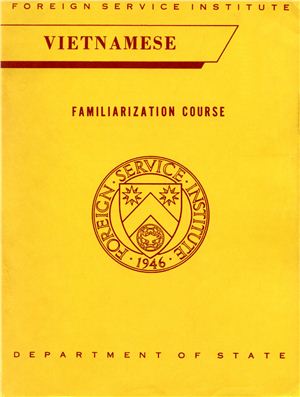Издательство: Foreign Servise Institute.
Год: 1969.
Количество страниц: 250.
Язык: Английский, вьетнамский.
Vietnamese Familiarization Course provides an, introduction to the Vietnamese language as it is spoken in South Vietnam. The most basic structural pattes of the lan,guage have been introduced along with vocabulary that is generally useful for Americans in Vietnam.
While this course is designed for classroom use, special attention has been given both in the text an,d in the tape recordings to make it as useful as possible for self-instructional use.
The Vietnamese material in this course was provided by NguyenHy-Quang, in consultation with other members of the Vietnamese staff of the F oreign Service lnstitute. The linguist-in-charge was Eleanor H., Chairman, of the Department of East Asian Languages.
This volume contains twelve lessons, alI of which have the sae basic patte and involve the sae procedures. Each lesson requires many hours of study, in class and/or with recordings of the Vietnamese material. The method underlying these lessons is guided imitation; the aim is automaticity. Ideally, there are two teachers: under the supervision of a scientific linguist, who talks ABOUT Vietnamese, the student leas to speak the language in direct imitation of a tutor who is a native speaker of Vietnaese. The tutor drills on the Vietnamese in the text, providing an authentic model for the student to imitate. Statements on how the language is manipulated are included in the explanatory notes in the text, which may be supplemented,
if necessary, by further discussions on the part of the linguist. As a supplement to class hours with a tutor - or even, if necessary, as a replacement for them - students work with tape recordings which approximate the classroom situation.
Год: 1969.
Количество страниц: 250.
Язык: Английский, вьетнамский.
Vietnamese Familiarization Course provides an, introduction to the Vietnamese language as it is spoken in South Vietnam. The most basic structural pattes of the lan,guage have been introduced along with vocabulary that is generally useful for Americans in Vietnam.
While this course is designed for classroom use, special attention has been given both in the text an,d in the tape recordings to make it as useful as possible for self-instructional use.
The Vietnamese material in this course was provided by NguyenHy-Quang, in consultation with other members of the Vietnamese staff of the F oreign Service lnstitute. The linguist-in-charge was Eleanor H., Chairman, of the Department of East Asian Languages.
This volume contains twelve lessons, alI of which have the sae basic patte and involve the sae procedures. Each lesson requires many hours of study, in class and/or with recordings of the Vietnamese material. The method underlying these lessons is guided imitation; the aim is automaticity. Ideally, there are two teachers: under the supervision of a scientific linguist, who talks ABOUT Vietnamese, the student leas to speak the language in direct imitation of a tutor who is a native speaker of Vietnaese. The tutor drills on the Vietnamese in the text, providing an authentic model for the student to imitate. Statements on how the language is manipulated are included in the explanatory notes in the text, which may be supplemented,
if necessary, by further discussions on the part of the linguist. As a supplement to class hours with a tutor - or even, if necessary, as a replacement for them - students work with tape recordings which approximate the classroom situation.

